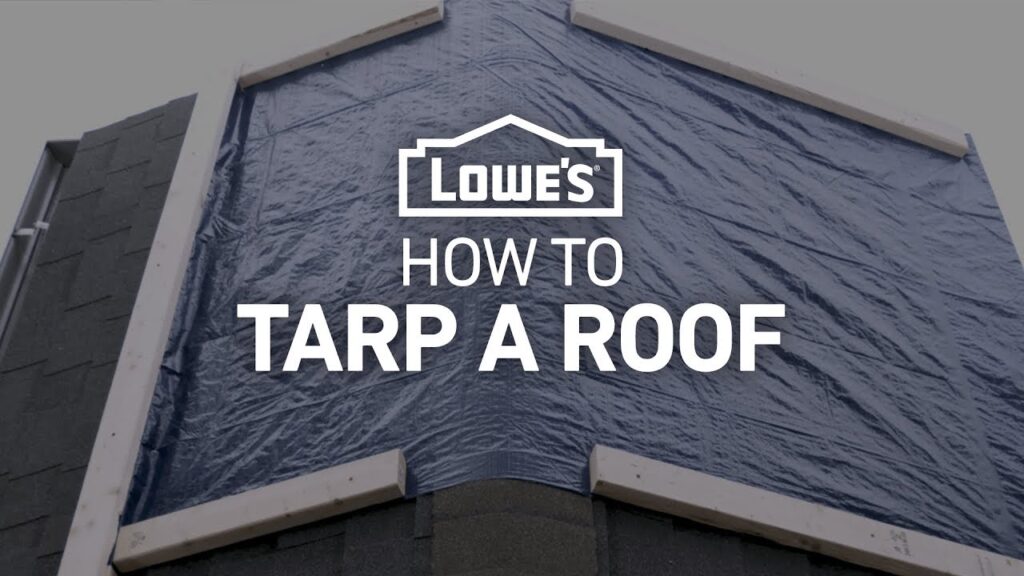Using a blue tarp to cover a damaged roof temporarily can be a quick and inexpensive solution to prevent further water damage until proper repairs can be made. However, it’s essential to keep in mind that a blue tarp is not a permanent fix and should only be considered a short-term solution. Here are some tips for using a blue tarp on your roof:
- Select the Right Size:
- Choose a tarp that is large enough to cover the damaged area with some overhang on each side.
- Secure Properly:
- Avoid Ponding Water:
- Tarp should be stretched tightly to avoid sagging, which could lead to water pooling. Ponding water can cause additional damage.
- Cover the Entire Affected Area:
- Make sure the entire damaged section is covered, extending beyond the damaged area to prevent rainwater from seeping underneath.
- Inspect Regularly:
- Regularly check the tarp for any damage or signs of wear. Replace it if needed to maintain its effectiveness.
- Temporary Solution:
- Understand that a blue tarp is a temporary fix. It is not a long-term solution and should not replace proper roof repairs.
- Professional Inspection and Repair:
- Seek professional advice to assess the extent of the damage and plan for permanent repairs. A qualified roofing professional can provide the best guidance on how to address the issue.
While a blue tarp can help protect against immediate rain, it is crucial to address the underlying roofing problems as soon as possible. Prolonged reliance on a tarp may lead to further issues and compromise the structural integrity of your home. Always consult with roofing professionals to ensure the safety and integrity of your roof.
Also a good way of Identifying
Absolutely, identifying the source of roof water damage is crucial to implementing effective repairs and preventing future issues. Here are steps to help you find the source of roof water damage:
- Interior Inspection:
- Begin by inspecting the interior of your home. Look for water stains on ceilings and walls. Follow the trail of any stains to the highest point on the ceiling; this is often close to the source of the leak.
- Attic Examination:
- If accessible, inspect the attic during or immediately after rain. Look for signs of water intrusion, such as damp insulation, water stains, or visible leaks. Use a flashlight to examine all areas of the attic.
- Exterior Inspection:
- Safely inspect your roof from the outside. Look for missing or damaged shingles, cracked flashing around chimneys or vents, and damaged roofing materials. Check for any obvious signs of wear or disrepair.
- Check Flashing:
- Flashing is a common source of leaks. Inspect the flashing around chimneys, skylights, vents, and other roof protrusions. Ensure that it is properly sealed and in good condition.
- Gutters and Downspouts:
- Clogged or damaged gutters can lead to water backing up under the roofing materials. Check gutters and downspouts for debris, and ensure they are properly directing water away from the house.
- Roof Valleys:
- Roof valleys are vulnerable areas where water can accumulate. Inspect these areas for signs of wear or damage.
- Ventilation:
- Poor ventilation can contribute to moisture problems. Ensure that your attic is well-ventilated to prevent condensation and mold growth.
- Professional Inspection:
- If you’re unable to identify the source of the leak or if the damage is extensive, consider hiring a professional roofing contractor. They have the expertise and experience to identify and address roofing issues.
- Document the Damage:
- Take photos or videos of the damage and the areas where you suspect the leak is occurring. This documentation can be useful when working with insurance companies or contractors.
Remember, it’s important to address roof water damage promptly to prevent further structural issues and mold growth. If you’re unsure about how to proceed, consult with a qualified roofing professional for a thorough inspection and appropriate repairs.
